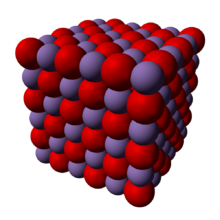أكسيد المنغنيز الثنائي
Manganese(II) oxide is an inorganic compound with chemical formula MnO.[2] It forms green crystals. The compound is produced on a large scale as a component of fertilizers and food additives.
. . . . . . . . . . . . . . . . . . . . . . . . . . . . . . . . . . . . . . . . . . . . . . . . . . . . . . . . . . . . . . . . . . . . . . . . . . . . . . . . . . . . . . . . . . . . . . . . . . . . . . . . . . . . . . . . . . . . . . . . . . . . . . . . . . . . . . . . . . . . . . . . . . . . . . . . . . . . . . . . . . . . . . . .
Structure, stoichiometry, reactivity
Like many monoxides, MnO adopts the rock salt structure, where cations and anions are both octahedrally coordinated. Also like many oxides, manganese(II) oxide is often nonstoichiometric: its composition can vary from MnO to MnO1.045.[3]
Below 118 K MnO is antiferromagnetic.[3] MnO has the distinction of being one of the first compounds[4] to have its magnetic structure determined by neutron diffraction, the report appearing in 1951.[5] This study showed that the Mn2+ ions form a face centered cubic magnetic sub-lattice where there are ferromagnetically coupled sheets that are anti-parallel with adjacent sheets.
Manganese(II) oxide undergoes the chemical reactions typical of an ionic oxide. Upon treatment with acids, it converts to the corresponding manganese(II) salt and water.[3] Oxidation of manganese(II) oxide gives manganese(III) oxide.
Preparation and occurrence
MnO occurs in nature as the rare mineral manganosite.
It is prepared commercially by reduction of MnO2 with hydrogen, carbon monoxide or methane, e.g.:[2]
- MnO2 + H2 → MnO + H2O
- MnO2 + CO → MnO + CO2
Upon heating to 450 °C, manganese(II) nitrate gives a mixture of oxides, MnO2-x, which can be reduced to the monoxide with hydrogen at ≥750 °C.[6] MnO is particular stable and resists further reduction.[7] MnO can also be prepared by heating the carbonate:[8]
- MnCO3 → MnO + CO2
This calcining process is conducted anaerobically, lest Mn2O3 form.
An alternative route, mostly for demonstration purposes, is the oxalate method, which also applicable to the synthesis of ferrous oxide and stannous oxide. Upon heating in an oxygen-free atmosphere (usually CO2), manganese(II) oxalate decomposes into MnO:[9]
- MnC2O4·2H2O → MnO + CO2 + CO + 2 H2O
Applications
Together with manganese sulfate, MnO is a component of fertilizers and food additives. Many thousands of tons are consumed annually for this purpose. Other uses include: a catalyst in the manufacture of allyl alcohol, ceramics, paints, colored glass, bleaching tallow and textile printing.[2]
References
- ^ أ ب Zumdahl, Steven S. (2009). Chemical Principles 6th Ed. Houghton Mifflin Company. p. A22. ISBN 978-0-618-94690-7.
- ^ أ ب ت Arno H. Reidies "Manganese Compounds" Ullmann's Encyclopedia of Chemical Technology 2007; Wiley-VCH, Weinheim. DOI:10.1002/14356007.a16_123
- ^ أ ب ت Greenwood, Norman N.; Earnshaw, Alan (1997). Chemistry of the Elements (2nd ed.). Butterworth-Heinemann. ISBN 978-0-08-037941-8.
- ^ J.E Greedon, (1994), Magnetic oxides in Encyclopedia of Inorganic chemistry Ed. R. Bruce King, John Wiley & Sons ISBN 0-471-93620-0
- ^ Shull, C. G.; Strauser, W. A.; Wollan, E. O. (1951-07-15). "Neutron Diffraction by Paramagnetic and Antiferromagnetic Substances". Physical Review. American Physical Society (APS). 83 (2): 333–345. doi:10.1103/physrev.83.333. ISSN 0031-899X.
- ^ H. Lux (1963). "Manganeses(II) Oxide". In G. Brauer (ed.). Handbook of Preparative Inorganic Chemistry, 2nd Ed. Vol. 2pages=1455. NY,NY: Academic Press.
- ^ Wellbeloved, David B.; Craven, Peter M.; Waudby, John W. (2000). "Manganese and Manganese Alloys". Ullmann's Encyclopedia of Industrial Chemistry. doi:10.1002/14356007.a16_077. ISBN 3527306730.
- ^ W.H. McCarroll (1994) Oxides- Solid State Chemistry, Encyclopedia of Inorganic Chemistry Ed. R. Bruce King, John Wiley & Sons ISBN 0-471-93620-0
- ^ Arthur Sutcliffe (1930) Practical Chemistry for Advanced Students (1949 Ed.), John Murray - London.

